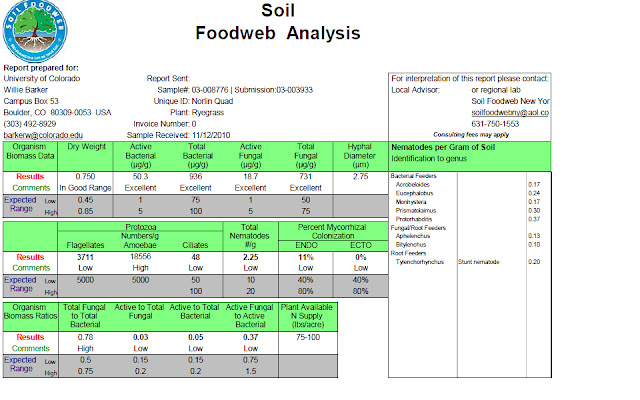Recently we worked with a company to discuss our Turfgrass Management Practices. The consulatant believed our cultural practices were very solid within our Turfgrass Management program. He discussed the introduction of a compost tea program to help increase our microbial life in our soil. In a previous post, I discussed our history of working towards increasing the microbial life and what tools we have been using for 9 years.
When we chose to implement this compost tea brewing program we were very curious to know what amounts and types of microbial life we already had and how well we had been doing in the past 9 years increasing these numbers. The problem has been not having the factual data to display these numbers. Within the past couple of years a new test has come online that is called a Soil Bio-Assay test. This test involves a company actually looking through a microscope and counting, indentifying and sizing out microbial, bacterial and fungal life in our soil. These tests are not cheap, but the information we get is honestly priceless.
The soil food web image above illustrates how the soil profiles are all tied together with many levels of organisms. As with any other eco-system, if you dont have enough of a certain species then the eco-system will get out of whack and you will have too many of certain things. Depending on what that species is it can become detrimental to the entire eco-system. It is all about checks and balances. As you can see in the above diagram it all starts with good levels of organic matter-which we have good levels of-and then working to increase the levels of bacteria; which in turn help to increase the entire food web.
The test above is one example of our food web test. This location is the Norlin Quadrangle and has always been a place where good practices have been used because of its location and importance. As you can see we have been doing pretty well at feeding the organisms that exist and trying to increase these numbers is the goal. The compost tea brew will be a major factor in introducing more of these bacteria and microbial life to speed up Mother Nature as well as help to inoculate more of the organisms to areas where new construction has happened and the soil is effectively dead.
If you were to look between these two test you will see some higher numbers of organisms in the test just above (Varsity Lawn) compared to the Norlin Quadrangle test. I have my theories as to why it is so much different. Both places have the same type of irrigation and cultural practices including the same Richlawn 5-3-2 fertilizer and the locations are within 500ft of each other. If you were to think of these two locations though, the Norlin Quad has a few trees along the perimeter otherwise it is mostly an open lawn. As for the Varsity lawn location, the area has a very high concentration of deciduous trees.
Before changes were made to the grounds program 9 years ago, the leaves on campus were all picked up and removed from campus. If you think of what Mother Nature does she expends nutrients to make those leaves so why not put them back. 9 years ago we started to mow all the leaves back into the lawn areas by using mulching decks on our mowers. I believe by returning these heavy amounts of leaves we have provided a great "food" for the first level organisms, this gave them the ability to increase in numbers which helps to sustain a higher amount of each level of organism in other levels of the food web.
These tests for Turf Managers, like myself, are amazing. To be able to see proof of what you where taught in school, and to know that the practices you have been doing are making a huge difference, provides a great sense of satisfaction to our whole team!
Ryan


